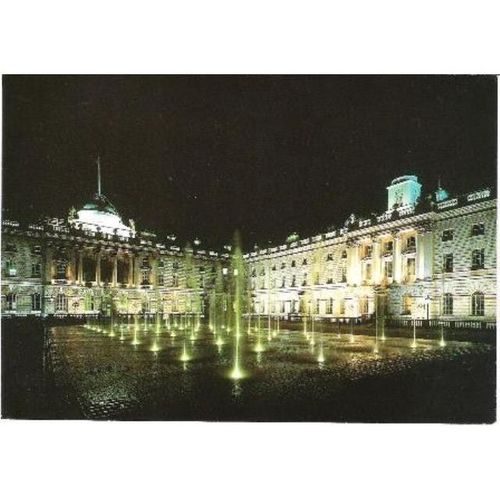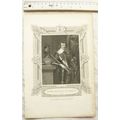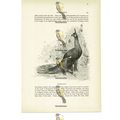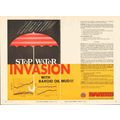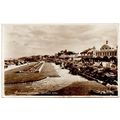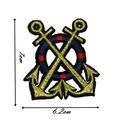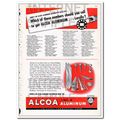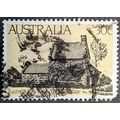London - Somerset House - Fountain Court at night - postcard c.1980s
- Condition : Used
- Dispatch : 2 Days
- Brand : None
- ID# : 130101330
- Quantity : 1 item
- Views : 271
- Location : United Kingdom

- Seller : justthebook (+1699)
- Barcode : None
- Start : Wed 09 Jul 2014 12:00:57 (EDT)
- Close : Run Until Sold
- Remain : Run Until Sold
Checks/Cheques
 for 1 item(s) edit
for 1 item(s) edit
Shipping Calculator
More Listings from This Seller view all
Seller's Description
- Postcard
- Picture / Image: The Edward J Safra Fountain Court at night - photo by Peter Durant
- Publisher: Somerset House / Unichrome / Jarrold
- Postally used: no
- Stamp: n/a
- Postmark(s): n/a
- Sent to: n/a
- Notes / condition: slightly larger modern size
Please ask if you need any other information and I will do the best I can to answer.
Image may be low res for illustrative purposes - if you need a higher definition image then please contact me and I may be able to send one.
------------------------------------------------
Postage & Packing:
Postage and packing charge should be showing for your location (contact if not sure).
No additional charges for more than one postcard. You can buy as many postcards from me as you like and you will just pay the fee above once. (If buying postcards with other things such as books, please contact or wait for invoice before paying).
Payment Methods:
UK - PayPal, Cheque (from UK bank) or postal order
Outside UK: PayPal ONLY (unless otherwise stated) please. NO non-UK currency checks or money orders (sorry).
NOTE: All postcards are sent in brand new stiffened envelopes which I have bought for the task. These are specially made to protect postcards and you may be able to re-use them. In addition there are other costs to sending so the above charge is not just for the stamp!
I will give a full refund if you are not fully satisfied with the postcard.
----------------------------------------------
Text from the free encyclopedia WIKIPEDIA may appear below to give a little background information (internal links may not work) :
*************
Somerset House is a large Neoclassical building situated on the south side of the Strand in central London, England, overlooking the River Thames, just east of Waterloo Bridge. The building, originally the site of a Tudor palace, was designed by Sir William Chambers in 1776, and further extended with Victorian wings to the north and south.[2][3] The East Wing forms part of the adjacent King's College London.[4]
In the sixteenth century, the north bank of the Thames between London and Westminster was a favoured site for the mansions of the nobility.[citation needed] In 1539, Edward Seymour, Earl of Hertford, obtained a grant of land at ""Chester Place, outside Temple Bar, London"" from King Henry VIII. When the boy-king Edward VI came to the throne in 1547, Seymour became Duke of Somerset and Lord Protector. About 1549 he pulled down an old Inn of Chancery and other houses that stood on the site and began to build himself a truly imposing residence, making liberal use of the other nearby buildings including some of the chantries and cloisters at St. Paul's Cathedral which were demolished at the behest of Somerset and other leading Protestant nobles as part of the ongoing Dissolution of the Monasteries. It was a two storey house built around a quadrangle with a gateway rising to three stories and was one of the earliest examples of Renaissance architecture in England. It is not known who designed the building.
Before it was finished, however, Somerset created too many enemies for himself in the Council.[citation needed] In the struggle for power he was overthrown and in 1552 and was executed at Tower Hill. ""Somerset Place"" then came into the possession of the Crown. The future Queen Elizabeth I lived there during the reign of her half-sister, Queen Mary I. The process of completion and improvement was slow and costly. As late as 1598 Stow refers to it as ""yet unfinished"".
In the 17th century, the house was used as a residence by queens consort. During the reign of King James I, the building became the London residence of his wife, Anne of Denmark, and was renamed Denmark House. She commissioned a number of expensive additions and improvements, some to designs by Inigo Jones. In particular, during the period between 1630 and 1635 he built a Chapel where Henrietta Maria of France, wife of King Charles I, could exercise her Roman Catholic religion. This was in the care of the Capuchin Order and was on a site to the south-west of the Great Court. A small cemetery was attached and some of the tombstones are still to be seen built into one of the walls of a passage under the present quadrangle.
Royal occupation of Somerset House was interrupted by the English Civil War and in 1649 Parliament tried to sell it. They failed to find a buyer, though a sale of the contents realised the very considerable sum (for that time) of £118,000. Use was still found for it however. Part of it served as an Army headquarters, General Fairfax (the Parliamentary Commander-in-Chief) being given official quarters there; lodgings were also provided for certain other Parliamentary notables. It was in Somerset House that Oliver Cromwell's body lay in state after his death in 1658.
Two years later, with the Restoration, Queen Henrietta Maria returned and in 1661 began a considerable programme of rebuilding, the main feature of which was a magnificent new river front, again to the design of the late Inigo Jones, who had died at Somerset House in 1652. However she returned to France in 1665 before it was finished. It was then used as an occasional residence by Catherine of Braganza, wife of King Charles II. During her time it received a certain notoriety as being, in the popular mind, a hot-bed of Catholic conspiracy. Titus Oates made full use of this prejudice in the fabricated details of the Popish Plot and it was alleged that Sir Edmund Berry Godfrey, whose murder was one of the great mysteries of the age, had been killed in Somerset House before his body had been smuggled out and thrown into a ditch below Primrose Hill.
Somerset House was refurbished by Sir Christopher Wren in 1685. After the Glorious Revolution in 1688, Somerset House entered on a long period of decline, being used (after Queen Catherine left England in 1692) for grace and favour residences. In the conditions of the time this meant almost inevitably that little money could be found for its upkeep, and a slow process of decay crept in. During the 18th century, however, the building ceased its royal associations. Though the view from its terraced riverfront garden, open to the public, was painted twice on his London visit by Canaletto (looking upriver and down), it was used for storage, as a residence for visiting overseas dignitaries and as a barracks for troops. Suffering from neglect, Old Somerset House began to be demolished in 1775.
Since the middle of the 18th century there had been growing criticism that London had no great public buildings. Government departments and the learned societies were huddled away in small old buildings all over the city. Developing national pride found comparison with the capitals of the Continent disquieting. Edmund Burke was the leading proponent of the scheme for a ""national building"", and in 1775 Parliament passed an Act for the purpose of, inter alia, ""erecting and establishing Publick Offices in Somerset House, and for embanking Parts of the River Thames lying within the bounds of the Manor of Savoy"". The list of ""Publick Offices"" mentioned in the Act comprised ""The Salt Office, The Stamp Office, The Tax Office, The Navy Office, The Navy Victualling Office, The Publick Lottery Office, The Hawkers and Pedlar Office, The Hackney Coach Office, The Surveyor General of the Crown Lands Office, The Auditors of the Imprest Office, The Pipe Office, The Office of the Duchy of Lancaster, The Office of the Duchy of Cornwall, The Office of Ordinance, The King's Bargemaster's House, The King's Bargehouses"".
Sir William Chambers, Surveyor-General of Works was appointed at a salary of £2,000 p.a. to design and build the new Somerset House. He spent the last two decades of his life, beginning in 1775, in several phases of building at the present Somerset House. Thomas Telford, then a stonemason, but later an eminent civil engineer, was among those who worked on its construction. One of Chambers's most famous pupils, Thomas Hardwick Jr, helped build parts of the building during his period of training and later wrote a short biography of Chambers. By 1780 the North Wing, fronting the Strand, was complete. Its design was based on Inigo Jones's drawings for the riverfront of the former building.
We do not know for certain at what pace the rest of the construction progressed, but it is clear that the outbreak of war with France caused delays through lack of money. Chambers died in 1796; most of the building was completed after Chambers' death by James Wyatt. However we know that building work was still going on in 1801; and there are indications that as late as 1819 some decorative work still needed to be completed. This original building (which did not yet include the ""New Wing"" and King's College London, situated behind the West and East Wings of the quadrangle respectively) probably cost about £500,000.
At that time the river was not embanked and the Thames lapped the South Wing where three great arches allowed boats and barges to penetrate to landing places within the building.
type=printed postcards
theme=topographical: british
sub-theme=england
county/ country=london
number of items=single
period=1945 - present
postage condition=unposted
Listing Information
| Listing Type | Gallery Listing |
| Listing ID# | 130101330 |
| Start Time | Wed 09 Jul 2014 12:00:57 (EDT) |
| Close Time | Run Until Sold |
| Starting Bid | Fixed Price (no bidding) |
| Item Condition | Used |
| Bids | 0 |
| Views | 271 |
| Dispatch Time | 2 Days |
| Quantity | 1 |
| Location | United Kingdom |
| Auto Extend | No |

